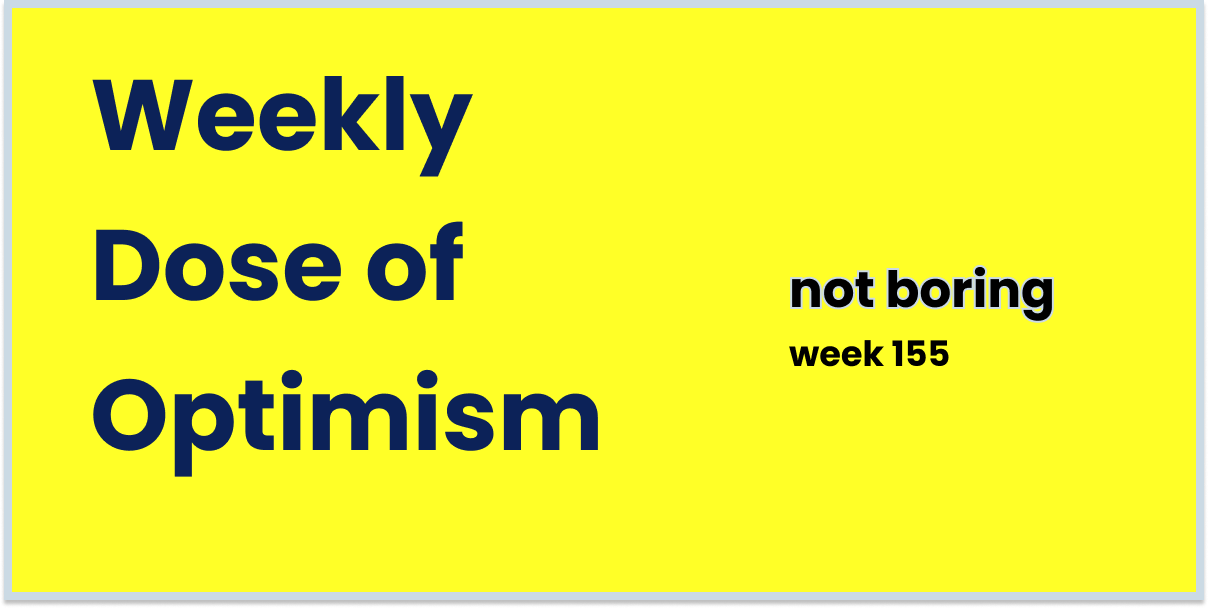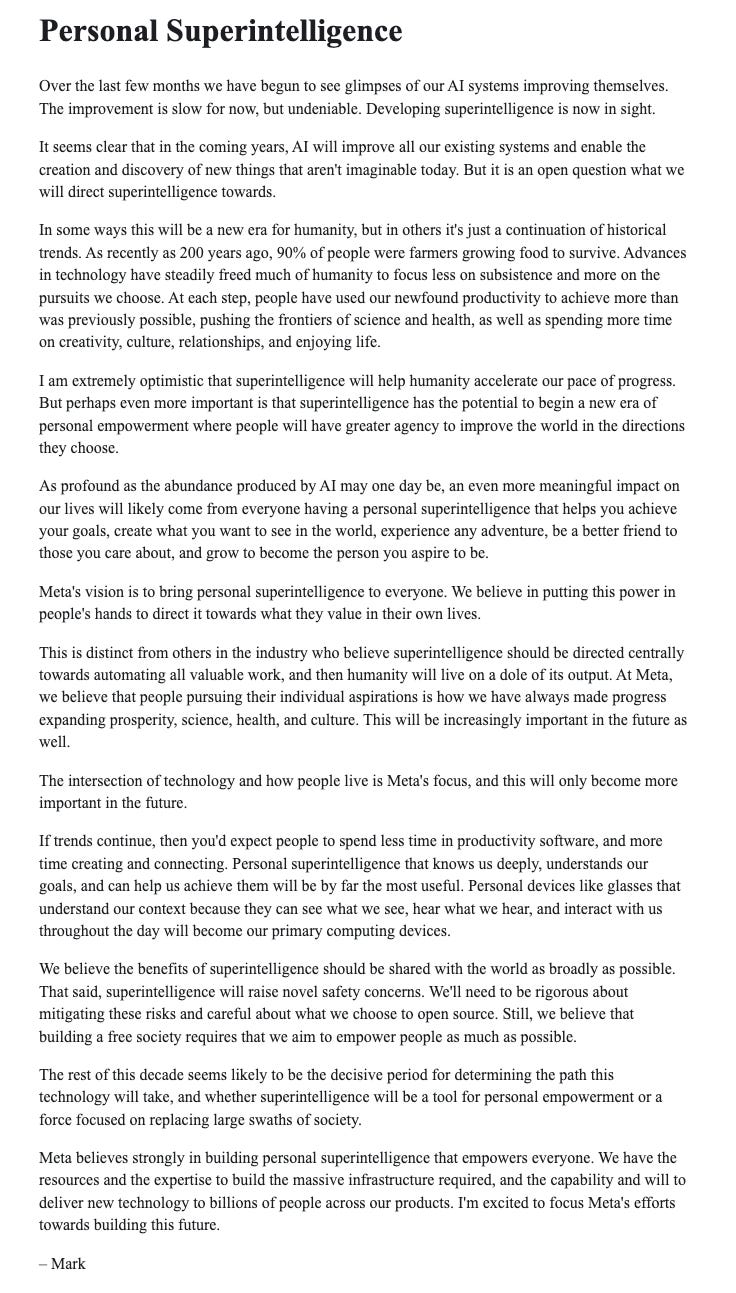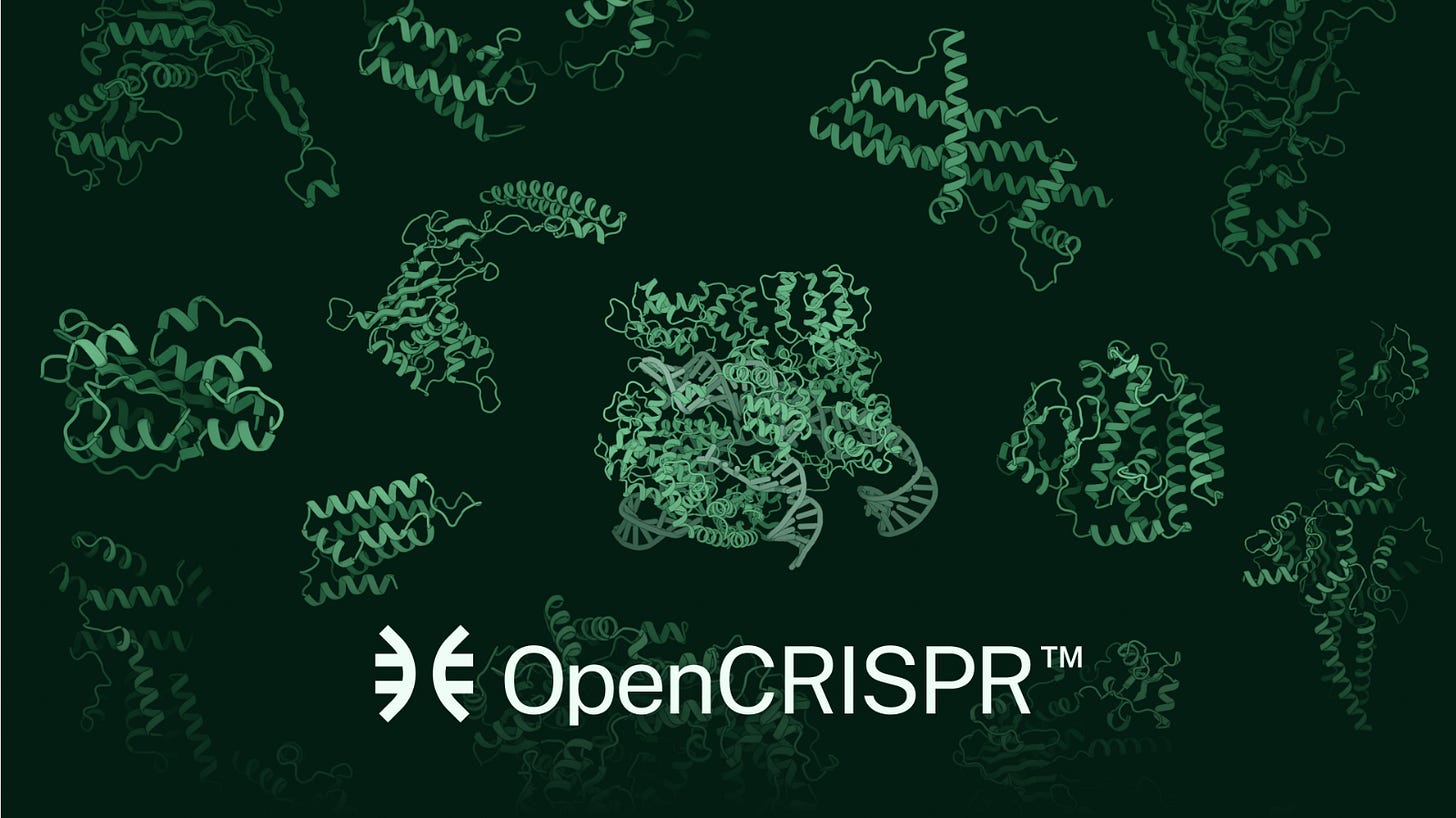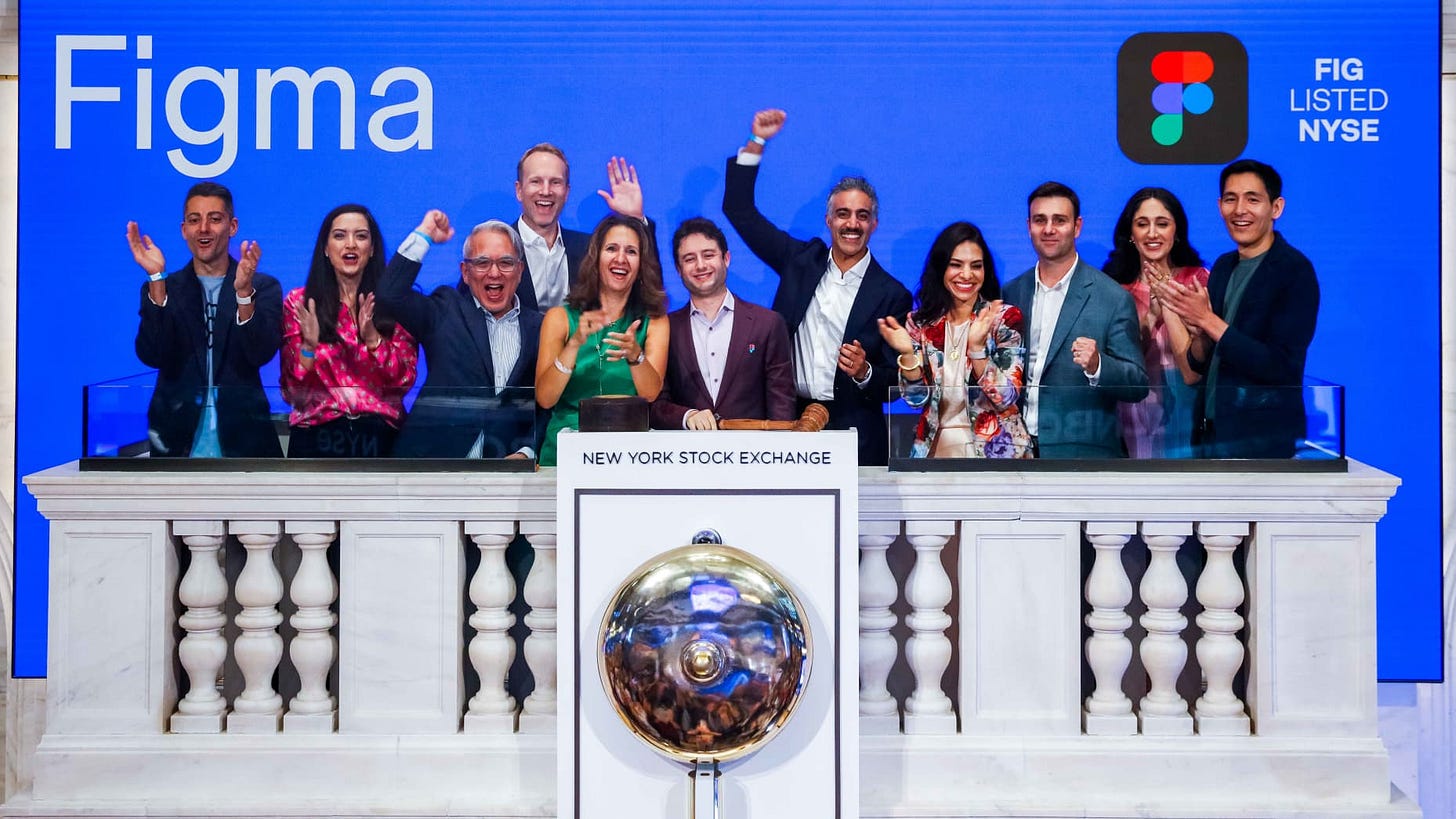Weekly Dose of Optimism #155
Personal Superintelligence, Iron-Air Batteries, OpenCRISPR-1, Figma, Zipline
Hi friends 👋 ,
Happy Friday and welcome back to our 155th Weekly Dose of Optimism. This marks one hundred and schfifty-five editions sent piping hot into your inbox. And we have a doozy of a week to celebrate: self-improving AI, deployed iron-air batteries, AI designed gene editors, Figma’s IPO, and some Zipline content. Couldn’t think of a better way to celebrate.
Let’s get to it.
Today’s Weekly Dose is brought to you by… Stripe Startups
Every venture-backed company — yes, you — should work with Stripe Startups.
Stripe’s mission is to increase the GDP of the internet, and it’s working. Last year, 1.3% of global GDP flowed through Stripe, over $1.4 trillion and growing. 78% of the Forbes AI 50 use Stripe’s financial infrastructure to monetize faster, experiment with pricing, and grow revenue.
As I wrote in my original Deep Dive, Stripe’s strategy from the earliest days has been to make it as easy as possible for startups to begin accepting payments, and then grow with them as they get really big. Little companies become big companies become public companies.
With Stripe Startups, they’re making it even easier.
Stripe Startups is the company’s new program designed to support early-stage, venture-backed businesses as they build, iterate, and scale. Founders enrolled in Stripe Startups get access to credits to offset Stripe fees, expert insights, and a focused community of other founders building on Stripe.
You’re going to use Stripe anyway. Get the white-glove experience.
(1) Personal Superintelligence
From Meta
Over the last few months we have begun to see glimpses of our AI systems improving themselves. The improvement is slow for now, but undeniable. Developing superintelligence is now in sight.
The age of Superintelligence is nigh.
In a public memo, Mark Zuckerberg revealed that Meta has recently observed its AI self-improving, a key step in developing superintelligence. Self-improving AI means recursive progress, meaning the models can iteratively enhance their own capabilities without human intervention accelerating performance well beyond human-level.
In sharing this update, Zuck also laid out Meta’s AI business strategy called “Personal Superintelligence” or AI embedded in everyday devices (like AR glasses) that deeply understand and assist individuals. According to Zuck, unlike those big bad Other AI labs that just want to automate your work and steal your jobs (good framing, Meta PR), Personal Superintelligence is designed to empower billions of people to pursue their own goals using AI tailored to them.
Meta’s stock popped 10% Wednesday evening into Thursday (adding about ~1 Anthropic to its market cap), but it wasn’t even on this news. They just, as they are wont to do, crushed earnings. And a company that is crushing earnings from its core business, is given a bit more (like hundreds of billions of dollars more) leash to pursue longer-term research initiatives that may not have immediate payback, like Personal Superintelligence.
A few takes here:
If Meta is observing self-improving AI, the other labs probably are not far behind.
I am not sure I want to live in world of Reels powered by Personal Superintelligence, but hopefully an aligned Superintelligent AI will come up with other more fulfilling or productive ways to spend my time.
With Meta’s stock pumping and adding ~$175B overnight, Zuck’s talent acquisition spree is looking a lot more reasonable.
I have one basic rule that I live by: never doubt Zuck.
Packy note: I’m mixed on this one! We included it because Zuck’s vision for Personal Superintelligence is great, and he’s pulled together an All-Star team to build it. BUT there’s what Zuck says, and the job AI is currently doing for Meta. In its Q2 earnings Prepared Remarks, the company wrote:
This is not great. Zuck is saying “that superintelligence has the potential to begin a new era of personal empowerment where people will have greater agency to improve the world in the directions they choose,” but it is hard to argue that souping up the algorithms to pull people even deeper into their Reels feeds gives people greater agency. It’s the opposite. No one wants to spend 20% more time watching Reels. It wasn’t as if that was peoples’ goal but they just couldn’t figure out how to do it until Meta’s AI helped them spend 20% more time in the app.
This is exactly what David Foster Wallace warned about:
Like, at a certain point we’re gonna have to build up some machinery, inside our guts, to help us deal with this. Because the technology is just gonna get better and better and better and better. And it’s gonna get easier and easier, and more and more convenient, and more and more pleasurable, to be alone with images on a screen, given to us by people who do not love us but want our money. Which is all right. In low doses, right? but if that’s the basic main staple of your diet, you’re gonna die. In a meaningful way, you’re going to die.
As it stands, Meta is using regular AI to up the dose. Here’s hoping he means what he says when and if his new team really does build Superintelligence.
(2) Ore Energy connects world’s first grid-connected iron-air battery in Delft
Cate Lawrence for Tech.EU
Ore Energy, a Netherlands-based energy startup pioneering iron-air long-duration energy storage, today announced that it has successfully connected its flagship iron-air battery system to the electric grid in the city of Delft — the first iron-air system to be grid-connected and fully operational anywhere in the world.
Netherlands-based startup Ore Energy connected the world’s first grid-ready iron-air battery system in Delft, offering up to 100 hours of clean energy storage using only iron, air, and water. Unlike lithium-ion systems, which max out around 4–8 hours, iron-air batteries allow for multi-day load shifting.
Iron-air batteries store energy by using a simple chemical reaction: when the battery discharges, iron reacts with oxygen from the air and forms rust, releasing electricity. To recharge, electricity is used to reverse the reaction—turning the rust back into iron and storing energy again. It’s kind of like breathing in and out, but with metal and air instead of lungs.
Batteries are a key piece of the clean energy transition and they just keep getting better and cheaper. Iron-air batteries are even better: they have higher capacity and use cheap and abundant materials (like air and iron), which means places like the Netherlands and the U.S. are less reliant on the rare materials needed to power lithium-ion batteries.
In simulations, Ore’s system slashed renewable energy curtailment by 44% and reduced system-wide energy costs by up to 63%. The company has plans to scale to 50 GWh/year by 2030 and, unsurprisingly has to jump through a ton of EU regulatory hurdles to get there. In the U.S. the leading iron-air battery player is Form Energy, which has built some great infrastructure but, to my knowledge, has not yet deployed its batteries.
(3) Design of highly functional genome editors by modelling CRISPR–Cas sequences
Ruffolo et al in Nature
Here, using large language models2 trained on biological diversity at scale, we demonstrate successful precision editing of the human genome with a programmable gene editor designed with artificial intelligence. To achieve this goal, we curated a dataset of more than 1 million CRISPR operons through systematic mining of 26 terabases of assembled genomes and metagenomes. We demonstrate the capacity of our models by generating 4.8× the number of protein clusters across CRISPR–Cas families found in nature and tailoring single-guide RNA sequences for Cas9-like effector proteins.
Profluent Bio has released OpenCRISPR-1, the first gene editor designed entirely by an AI model (not discovered in nature or derived from a bacterial protein). The model, which was trained on over 1 million CRISPR systems mined from 26 terabases of genomic data, generated proteins with greater functional diversity than exists in the wild. OpenCRISPR-1 edits the human genome with precision equal to or better than SpCas9, but with fewer off-target effects and lower immunogenicity.
Profluent says it’s already being used in research and commercial applications, from drug discovery to cell therapies to crop engineering. The company’s goal is to replace trial-and-error discovery with bespoke design using its steerable, general-purpose protein models. I don’t know exactly what biotech and medicine will look like in the next 10–20 years, but I can say with a pretty high degree of certainty that it’s going to make our current approaches look medieval.
(4) Figma more than triples in NYSE debut after selling shares at $33
Jordan Novet for CNBC
Figma’s first trade at $85 valued the company at about $50 billion. The stock, trading under ticker symbol FIG, was halted after it soared past $112.
The IPO window is open, baby.
Figma, the infrastructure that supports the Not Boring design engine, priced its IPO at $33, for a market cap right below the $20 billion price tag for which Adobe tried to acquire it before Lina Khan spoiled the fun. Whatever, same price, no blood, no foul.
Then! As Bill Gurley clutched his stomach, put the back of his hand to his forehead, and fainted onto the couch like a cartoon character (presumably), it first traded hands at $85 before rocketing to $112, getting halted, opening back up, soaring to $122, and closing at $117.59. At that price, its market cap is $69 billion (nice), or 3.46 Linas.
In pre-market trading this morning, it’s at $138.48, $81.5 billion or 4.07 Linas.
A few weeks ago, we covered Figma filing its S-1. It was going public. We were optimistic but we still didn’t know how the market would react. Now we know. The market wants high-growth, high-margin, AI-exposed, founder-led tech stocks. Circle ripped. Figma ripped. If you’re a strong tech company, the market wants to meet you.
This is good for the venture market. LPs will be getting some real liquidity, and some hope that more is to come, which they can redeploy into venture, which means more companies fixing more problems (someone please fix Newark Airport, eg) and increasing humanity’s means.
And if you want to squint with us and get really optimistic, this may be the biggest wealth creation event for good designers in world history; billions and billions of dollars with which to make the world a little more beautiful.
(5) Zipline
From The Abunadnace Institute
We were promised flying cars; instead, we got flying delivery drones.
Zipline is one of our favorite companies. It’s been grinding away at a massive, hard problem for well over a decade: making vital and wanted product delivery cheaper, more accessible, and cleaner. It started with the vital products, delivering blood and other medicines throughout Rwanda via drones, and that business has since expanded globally.
Now it’s making a massive push into wanted products: quick commerce and food delivery, right here in the U.S. It even kicked off a partnership with Walmart a couple of months ago to offer fast (<30 min), autonomous drone delivery of thousands of products directly to customers’ homes.
Zipline is one of those companies that, on paper, makes so much sense. Why wouldn’t we want faster, cheaper, cleaner delivery of goods directly to our homes? Why would we want to lock up billions of human hours each year simply delivering food and convenience store items?
The demand for Zipline, in theory, has always been there. But now the company is starting to work through the execution and regulatory hurdles that have slowed it down in the past. Drones are getting cheaper, safer, and better, and the software running them is getting smarter. And now the FAA is starting to take notice: Zipline has amassed millions of miles of pristine safety data.
Demand + technology advancements + regulatory compliance might just = fast, nearly free delivery of Chipotle for Dano.
s/o to the Abundance Institute (where Packy is an Senior Advisor) and Jason Carman for putting together this awesome video on Zipline.
And as for me, I’ll be ziplining right onto my couch for the weekend.
Bonus: Means and Meaning
Means and Meaning
Welcome to the 1,148 newly Not Boring people who have joined us since our last essay! Join 247,246 smart, curious folks by subscribing here:
Packy here. I wrote one of my favorite essays I’ve written in a while this week, and sent it out at a weird time mid-morning Tuesday. It’s probably best read on a weekend morning with a big cup of coffee and a nice view. Enjoy!
Have a great weekend y’all.
Thanks to Stripe Startups for sponsoring. Love these guys, we don’t say that enough.
We’ll be back in your inbox next week.
Thanks for reading,
Packy + Dan









Yassss I love that you included schfifty five. Great song.
The schfifty-five video is forever etched into my memory. Thanks for reminding me of that beauty... I love you and dearly miss ebaumsworld glory.